 |
HISTORY |
 |
|
|
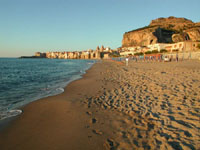 The
city of Cefalù, the ancient Kephalodion
- a greek term that means "Head" and refers to the natural
shape of the Rock which dominates the city - has a privileged position
in the territory of Palermo. The
city of Cefalù, the ancient Kephalodion
- a greek term that means "Head" and refers to the natural
shape of the Rock which dominates the city - has a privileged position
in the territory of Palermo.
Built around an imposing stronghold that had a defensive role in
the past centuries, Cefalù is one of the 15 Sicilian municipalities
of the Madonie Park, a natural and historical site which preserves
interesting archaeological finds - farms, churches, mills - as evidence
of the human passage on this area in the remote ages.
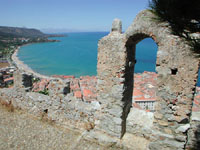 It
is a special place where the historical past is still alive in the
local handicraft activities and in the old folk wisdom, and perfectly
melting with the beauty of the natural park. It
is a special place where the historical past is still alive in the
local handicraft activities and in the old folk wisdom, and perfectly
melting with the beauty of the natural park.
The
visitor is struck by its natural position, the splendid Romanesque
Cathedral rising among a tangle of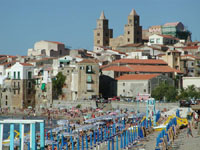 rues, the medieval elements scattered along the slopes, from the
Rock to the Corso Ruggero, dotted with little suggestive streets
and arches binding the buildings together.
rues, the medieval elements scattered along the slopes, from the
Rock to the Corso Ruggero, dotted with little suggestive streets
and arches binding the buildings together.
Nowadays
Cefalù has become a tourist seaside resort, equipped with
all sorts of tourist facilities, able to guard the signs of its
important past, while adapting its urban design to the needs of
a modern city.
The
origins of Cefalù are not certain but it would seem that
it originated from an indigenous site which grew and developed even
thanks to the contacts had with the several peoples which dominated
the area from the V century B.C. on.
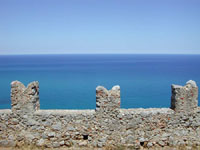 Cefalù
boasts several archaeological finds like the ruins of an ancients
castle, the Cathedral, renowned for its mosaics, the Madralisca
Palace which houses the homonymous museum containing outstanding
works of art. Cefalù
boasts several archaeological finds like the ruins of an ancients
castle, the Cathedral, renowned for its mosaics, the Madralisca
Palace which houses the homonymous museum containing outstanding
works of art.
The remains of a megalithic sanctuary, the Temple of Diana, lie
on the rock which dominates the city. The temple dates from the
IX century B.C. and are evidence of a human settlement since pre-Hellenic
times.
The archaeologists helped to reconstruct the history of the place
from its far off roots, when its name was Kephalodion and was in
contact with the Hellenistic centres of the Island.
Few though important archaeological finds were found on this area,
mostly in the caves of the "colombe" (doves) and of the
"giumente" (mares) and in the dolmen tank of the Temple
of Diana.
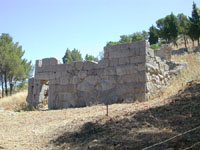 The
Temple of Diana was probably built in the V century
B.C. and afterwards restored. Its religious role is documented
by the nearby ruins of Byzantine churches. The
Temple of Diana was probably built in the V century
B.C. and afterwards restored. Its religious role is documented
by the nearby ruins of Byzantine churches.
It has a megalithic structure and a polygonal shape with big
blocks, various rooms and a corridor that leads to the only
access to the temple. |
The
historical documents recount that in the year 396 B.C. the inhabitants
of Kephalodion formed an alliance with Imilcone, a Carthaginian
general. Then, when Carthage expansion was stopped by Dionigi the
"old", Cefalù capitulated to Siracusa.
During
the first Punic war in 254 B.C. the city was conquered by the Romans
that called it Cephaloedium. Under this new domination the city
had to endure a period of decline and its role red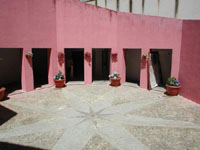 uced
to "civitas decumana". uced
to "civitas decumana".
After the Western Roman Empire collapse
there was a territorial withdraw as the urban settlements constantly
moved back from the coast to a new urban area, set on the Rock.
The
findings concerning the Hellenistic-Roman periods are the city walls,
the Temple of Diana, the ruins of several streets decorated with
rich pavements, the medieval alleys, the necropolis which shows
several monumental tombs ranging from the IV to the I century B.C.
|
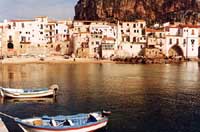 The
city walls are well preserved and give Cefalù
the aspect of an impregnable fortress. Their structure is
completed by towers and bastions. Particularly, the remains
of a tower were merged into the Church of the "Madonna
della Catena". The
city walls are well preserved and give Cefalù
the aspect of an impregnable fortress. Their structure is
completed by towers and bastions. Particularly, the remains
of a tower were merged into the Church of the "Madonna
della Catena".
On the northern side the walls are best preserved thanks to
the restoration works over the centuries. Here were recovered
most archaeological findings.
Originally, four doors gave access in town, and were called:
Porta Terra, Porta d'Arena or d'Ossuna, Porta della Giudecca
and Porta Marina. This last has only survived; it has a gothic
arch and offers a spectacular outlook over the sea.
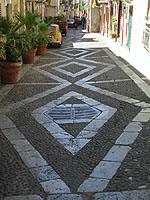 The
streets are renowned for their rich pavements.
Two are specially worth mentioning: a street from the Augustan
period situated under the cathedral and one, cobbled paved,
dating from the V century B.C., by the cathedral too. The
streets are renowned for their rich pavements.
Two are specially worth mentioning: a street from the Augustan
period situated under the cathedral and one, cobbled paved,
dating from the V century B.C., by the cathedral too.
The today's urban plan lies on the main street, the Corso
Ruggero, that split up the city in two areas: the medieval
quarter, on the one side, made up of a maze of streets and
views, and, on the other, one more regularly designed.
Another street harbours the mentioned Porta Marina and the
remains of a medieval wash-house, known as 'u ciuni' (the
river), that was still in use until a few years ago and whose
origins are not certain. Here, going down the lavic steps
you enter a room with a low roof and a vault. Some rock mouths
on the walls make the water flow into the room.
A cave under the building drives the 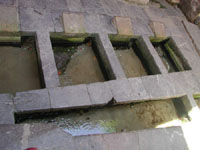 water
to the sea. Next to the wash-house there is the thermal baths
known as "Il Bagno di Cicero", which also gives
its name to a nearby square. water
to the sea. Next to the wash-house there is the thermal baths
known as "Il Bagno di Cicero", which also gives
its name to a nearby square.
Also worth mentioning are the ruins of three ancient dwellings,
dating back to the III-II century B.C. The historical importance
of these places is due to the recovery of a jar containing
some bronze coins from the late IV century B.C.
Anther important finding dates from this period: a mosaic
pavement showing some plants and animals among which stands
out a dove drinking from the bowl of eternal life.
Ancient inscriptions were found in the southern side of the
Hellenic necropolis, and are preserved in the Mandralisca
Municipal Museum.
|
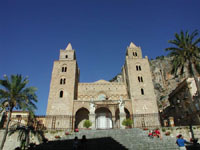 |
In
the year 858 Cefalù was conquered by the Arabs and annexed
to the Emirate of Palermo. They called it Gafludi.
With the coming of the Normans in 1063, headed by Ruggero
II, it began a period of wealth and prosperity, and
the city even became a bishop seat. |
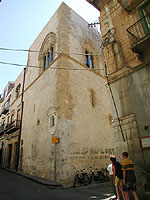 The
Norman settlement is testified by several monuments such as
the Arabian-Norman Cathedral and the Osterio Magno, Ruggero
II's probable residence, recently restored and opened as a public
place. The
Norman settlement is testified by several monuments such as
the Arabian-Norman Cathedral and the Osterio Magno, Ruggero
II's probable residence, recently restored and opened as a public
place.
The Osterio Magno's varied architectural elements are evidence
of the changes and the evolution of the building over the centuries.
It consists of two parts: one, more ancient, made of gild lavic
stone, from the end of the XIII century, whereas a quadrangular
tower characterizes the other more recent side. |
Cefalù
enjoyed a large economic prosperity until the second half of the
XII century, when the civil wars broke out in the Island, first
between the Swabians and Anjous, then between this latter and Aragonas..
During this period of contests the city was often under the control
of the Ventimiglia family, one of the most powerful of the reign.
New bloody conflicts struck Cefalù in the beginning of the
XV century, caused by the power struggle between the Vicar Queen
Bianca di Navarra and Bernardo Cabrera, between 1410 and 1412.
Starting from the XV century Cefalù met a new flourishing
period. In the following centuries the historic and politic events
of the city were strictly intertwined with those of the rest of
the Island.
|

